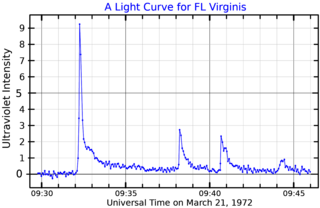
Wolf 424 is a binary star system comprising two red dwarf stars at a distance of approximately 14.2 light years from the Sun. It is located in the constellation Virgo, between the stars ε Virginis and ο Virginis.

OP Andromedae is a variable star in the constellation Andromeda. Varying between magnitudes 6.27 and 6.41 over 2.36 days, it has been classified as an RS Canum Venaticorum variable, but there has not been any proof of binarity, yet. It is a red giant star with a spectral classification of K1III.

2MASS J04414489+2301513 is a young star system hosting a planet and a couple of brown dwarfs, approximately 470 light years away.

c Puppis, also known as HD 63032 and HR 3017, is a spectroscopic binary star in the constellation Puppis. Its apparent magnitude is 3.61. Located around 347 parsecs (1,130 ly) distant, the primary is an orange-red bright giant or supergiant of spectral type K2.5Ib-IIa or K5IIa, while the secondary, discovered in 1983, is a blue main-sequence star of spectral type B9V. The system is the brightest member of the open cluster NGC 2451, over two magnitudes brighter than every other star in the cluster. As the turnoff point of the cluster is currently around B7, the parameters of the system fit with cluster membership.

G 9-38, also known as EI Cancri and GJ 1116, is a binary star system consisting of two M-type stars. At 16.7 light-years from the Sun, the system is relatively nearby. The system has a very high stellar flare activity, with average five flares per hour.
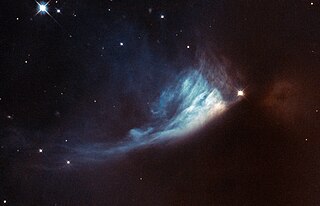
PV Cephei is variable star of Orion type located in the constellation of Cepheus at a distance of over 1600 light-years from Earth.
YBP 1194 is a G-type main-sequence star, class G5V, in the open cluster M67 in the constellation Cancer. It is the best solar twin found to date, having the near exact temperature and mass as the Sun. YBP 1194 has a higher metallicity than the Sun and is 0.5 billion years younger at an age of 4.2 billion years old, but due to the distance, the error bar is high at ±1.6 billion years. On December 19, 2013, it was announced to have an extrasolar planet with a period of 6.9 days and a high eccentricity of 0.24 with a mass of 0.34 MJ. It is about 2,772 light-years from the Sun. It is packed in a small cluster, Messier 67, with a radius of 10 ly, with over 500 other stars. For comparison, the Sun has 17 stars at a distance of 10 ly and about 134 stars at a distance of 20 ly.
ADS 7251 is a binary star system 6.33 parsecs from the Sun. The components are near-identical red dwarfs separated by 17″ in 2019.

WR 42e is a Wolf–Rayet star in the massive H II region NGC 3603 in the constellation of the Carina. It is around 25,000 light-years or 7,600 parsec from the Sun. WR 42e is one of the most massive and most luminous stars known.
EPIC 204278916 is a pre-main-sequence star, about five million years old with a spectral type of M1, implying a red dwarf. It is part of the Upper Scorpius sub-group of the Scorpius–Centaurus association, and is in the constellation Scorpius. The star is approximately the size of the Sun at 0.97 R☉, but is only half its mass (0.50 M☉) and a fraction of its luminosity (0.15 L☉).
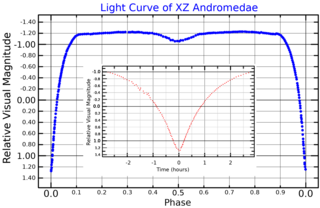
XZ Andromedae is a binary star in the constellation Andromeda. Its maximum apparent visual magnitude is 9.91, but drops down to 12.45 every 1.357 days. Its variability matches the behaviour of Algol variable stars.

BM Andromedae is a T Tauri star in the constellation Andromeda. Its apparent visual magnitude has irregular variations between a maximum of 11.63 and a minimum of 14.02.
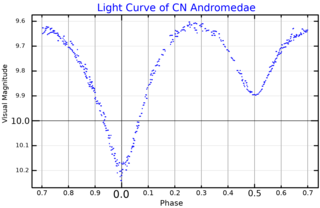
CN Andromedae is an eclipsing binary star in the constellation Andromeda. Its maximum apparent visual magnitude is 9.62 and drops down to a minimum of 10.2 during the main eclipse. It is classified as a Beta Lyrae variable with a period roughly of 0.4628 days.
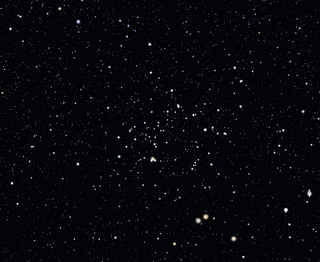
DS Andromedae is an eclipsing binary star in the constellation Andromeda and a member of the open cluster NGC 752. Its maximum apparent visual magnitude is 10.44, but drops down to 10.93 during the main eclipse and to 10.71 during the secondary one.

EU Andromedae is a carbon star in the constellation Andromeda. Its apparent visual magnitude varies in an irregular manner between 10.7 and 11.8.
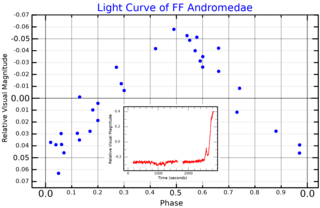
FF Andromedae is a spectroscopic binary in the constellation Andromeda. It has a typical apparent visual magnitude of 10.4, but undergoes flare events that can increase its brightness by about a magnitude.
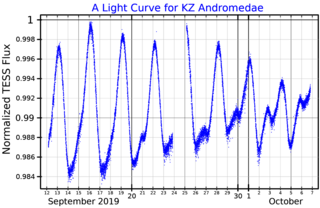
KZ Andromedae is a double lined spectroscopic binary in the constellation Andromeda. Its apparent visual magnitude varies between 7.91 and 8.03 during a cycle slightly longer than 3 days.
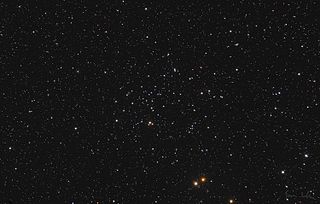
QX Andromedae is an eclipsing binary in the constellation Andromeda. It varies from a maximum apparent visual magnitude of 11.28 to a minimum of 11.50. Since it is impossible to specify the onset time of the eclipses, it is classified as a W Ursae Majoris variable star. It is also observed as an X-ray source and is a member of the open cluster NGC 752.

WR 133 is a visually moderately bright Wolf-Rayet star. It is a spectroscopic binary system containing a Wolf-Rayet primary and a class O supergiant secondary. It is in the constellation of Cygnus, lying in the sky at the centre of the triangle formed by β and γ Cygni, near η Cygni. It is the brightest member of the sparse open cluster NGC 6871.

QY Puppis is a K-type supergiant star in the constellation of Puppis. With a radius of 515 R☉, it is on the smaller end of the largest known stars.

















